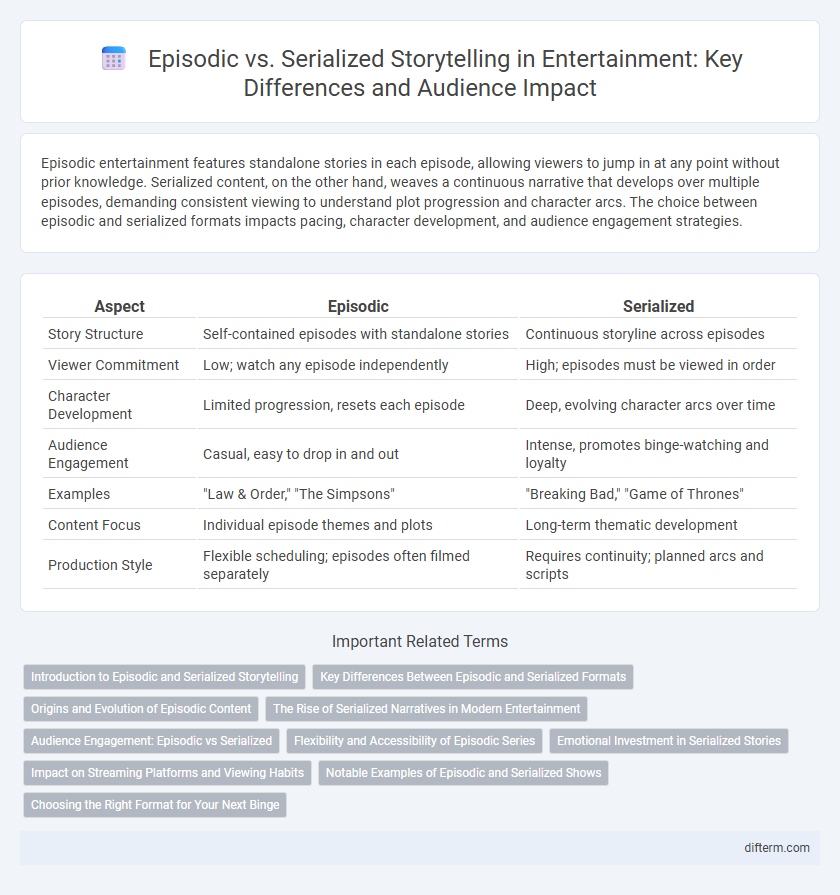Episodic entertainment features standalone stories in each episode, allowing viewers to jump in at any point without prior knowledge. Serialized content, on the other hand, weaves a continuous narrative that develops over multiple episodes, demanding consistent viewing to understand plot progression and character arcs. The choice between episodic and serialized formats impacts pacing, character development, and audience engagement strategies.
Table of Comparison
| Aspect | Episodic | Serialized |
|---|---|---|
| Story Structure | Self-contained episodes with standalone stories | Continuous storyline across episodes |
| Viewer Commitment | Low; watch any episode independently | High; episodes must be viewed in order |
| Character Development | Limited progression, resets each episode | Deep, evolving character arcs over time |
| Audience Engagement | Casual, easy to drop in and out | Intense, promotes binge-watching and loyalty |
| Examples | "Law & Order," "The Simpsons" | "Breaking Bad," "Game of Thrones" |
| Content Focus | Individual episode themes and plots | Long-term thematic development |
| Production Style | Flexible scheduling; episodes often filmed separately | Requires continuity; planned arcs and scripts |
Introduction to Episodic and Serialized Storytelling
Episodic storytelling presents self-contained stories within each episode, allowing viewers to jump in at any point without prior knowledge. Serialized storytelling weaves a continuous narrative across multiple episodes, demanding consistent viewing for full plot comprehension. Both formats shape audience engagement by balancing accessibility and narrative depth in entertainment media.
Key Differences Between Episodic and Serialized Formats
Episodic formats present standalone stories in each episode, allowing viewers to jump in at any point without prior knowledge, while serialized formats weave continuous narratives that unfold over multiple episodes, requiring sequential viewing for full understanding. Episodic shows emphasize self-contained plots, often resolving conflicts by the episode's end, whereas serialized series develop complex character arcs and storylines across a season or series. Viewer engagement differs as episodic formats cater to casual audiences, while serialized formats attract dedicated viewers invested in long-term storytelling.
Origins and Evolution of Episodic Content
Episodic content originated with early radio and television shows like "The Lone Ranger" and "I Love Lucy," which featured self-contained stories within each episode to attract casual viewers. This format evolved to prioritize accessibility and syndication potential, allowing networks to reach broader audiences without requiring prior knowledge of previous episodes. Over time, episodic storytelling established a formula that balanced character development with standalone plots, contrasting with serialized narratives that emphasize continuous story arcs.
The Rise of Serialized Narratives in Modern Entertainment
Serialized narratives dominate modern entertainment by delivering continuous story arcs that deepen character development and audience investment. Platforms like Netflix and HBO capitalize on binge-watching trends, releasing entire seasons that encourage sustained viewer engagement. This shift from episodic formats reflects changing consumer preferences for complex, interconnected storytelling in shows such as "Stranger Things" and "Game of Thrones.
Audience Engagement: Episodic vs Serialized
Episodic content allows viewers to enjoy standalone stories, making it easier to jump in at any point, which maintains consistent audience engagement by catering to casual watchers. Serialized storytelling fosters deeper emotional investment and sustained interest through ongoing plotlines and character development, encouraging viewers to follow every episode. Audience engagement in serialized shows often translates to higher binge-watching rates and stronger fan communities, while episodic formats benefit from accessibility and flexibility.
Flexibility and Accessibility of Episodic Series
Episodic series offer greater flexibility by allowing viewers to watch episodes independently without prior knowledge of previous installments, enhancing accessibility for casual audiences. This format caters to varying schedules and viewing habits, supporting on-demand consumption across diverse platforms. Consequently, episodic storytelling often attracts a broader audience by lowering barriers to entry compared to serialized narratives.
Emotional Investment in Serialized Stories
Serialized stories foster deeper emotional investment by developing characters and plotlines across multiple episodes, allowing viewers to form meaningful connections and experience evolving emotional arcs. This continuous narrative encourages audience retention and anticipation, as each installment builds upon previous events to heighten dramatic tension. Emotional complexity in serialized formats often results in stronger viewer loyalty compared to episodic stories, which reset conflict and character development each episode.
Impact on Streaming Platforms and Viewing Habits
Episodic content on streaming platforms fosters flexible viewing habits by allowing audiences to watch episodes independently, increasing binge-watching and casual consumption. Serialized series drive sustained engagement and subscription retention through continuous story arcs that encourage consistent, sequential viewing. The balance between episodic and serialized formats shapes platform algorithms and influences content acquisition strategies tailored to maximize viewer loyalty and platform growth.
Notable Examples of Episodic and Serialized Shows
Episodic shows like "The Simpsons" and "Law & Order" feature self-contained stories that can be enjoyed independently, making them accessible to casual viewers. Serialized shows such as "Breaking Bad" and "Game of Thrones" develop complex narratives over multiple episodes, encouraging continuous engagement and binge-watching. These formats shape viewer experience, with episodic series prioritizing variety and serialized series emphasizing character development and long-term plots.
Choosing the Right Format for Your Next Binge
Episodic formats offer standalone stories in each episode, making them ideal for casual viewing and easy accessibility, while serialized shows provide continuous narratives that reward long-term investment and deep character development. Selecting the right format depends on audience preferences: episodic suits viewers seeking variety and closure in short bursts, whereas serialized appeals to those craving immersive, plot-driven experiences. Understanding these dynamics helps creators tailor content to maximize engagement and binge-worthiness in competitive entertainment markets.
episodic vs serialized Infographic

 difterm.com
difterm.com